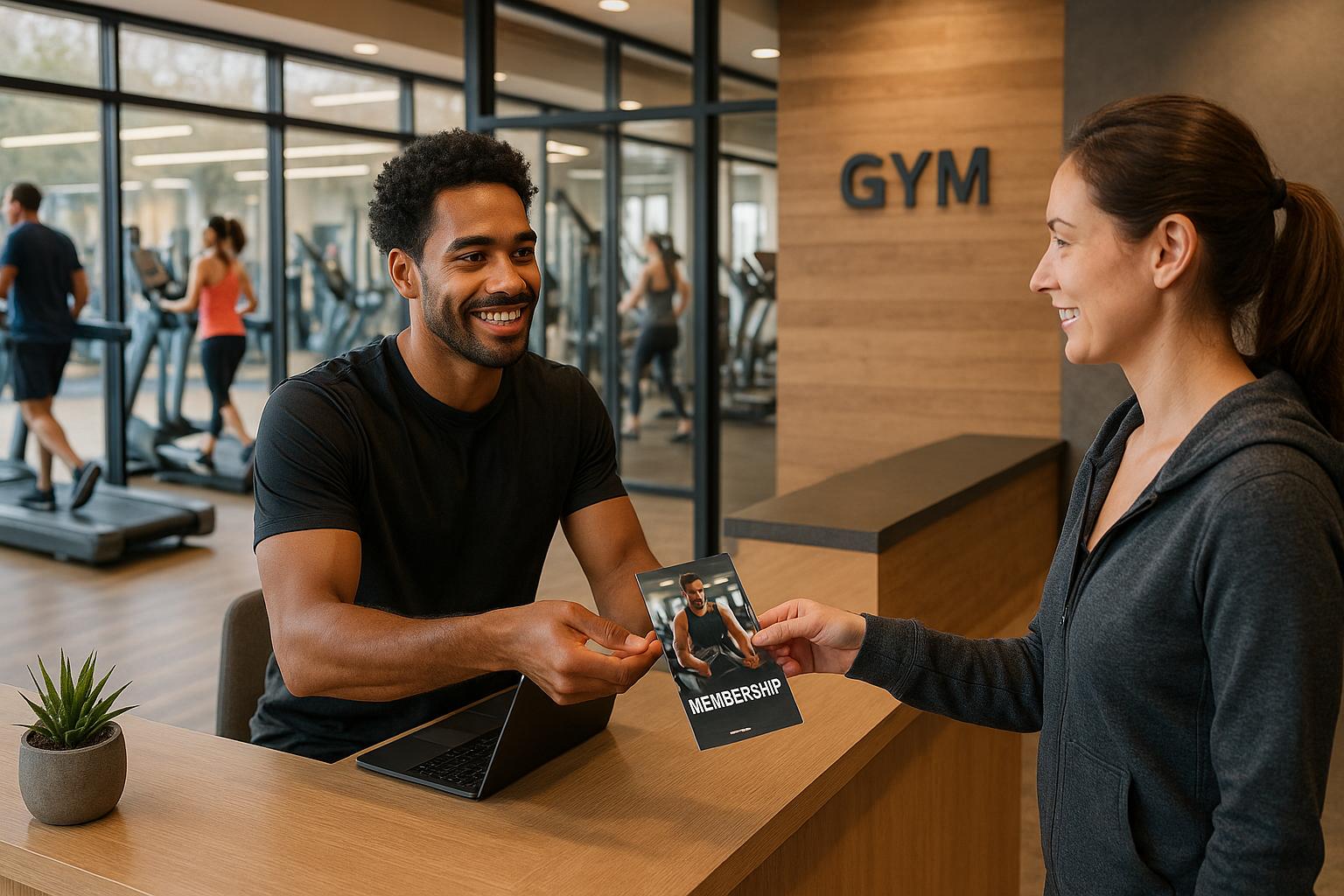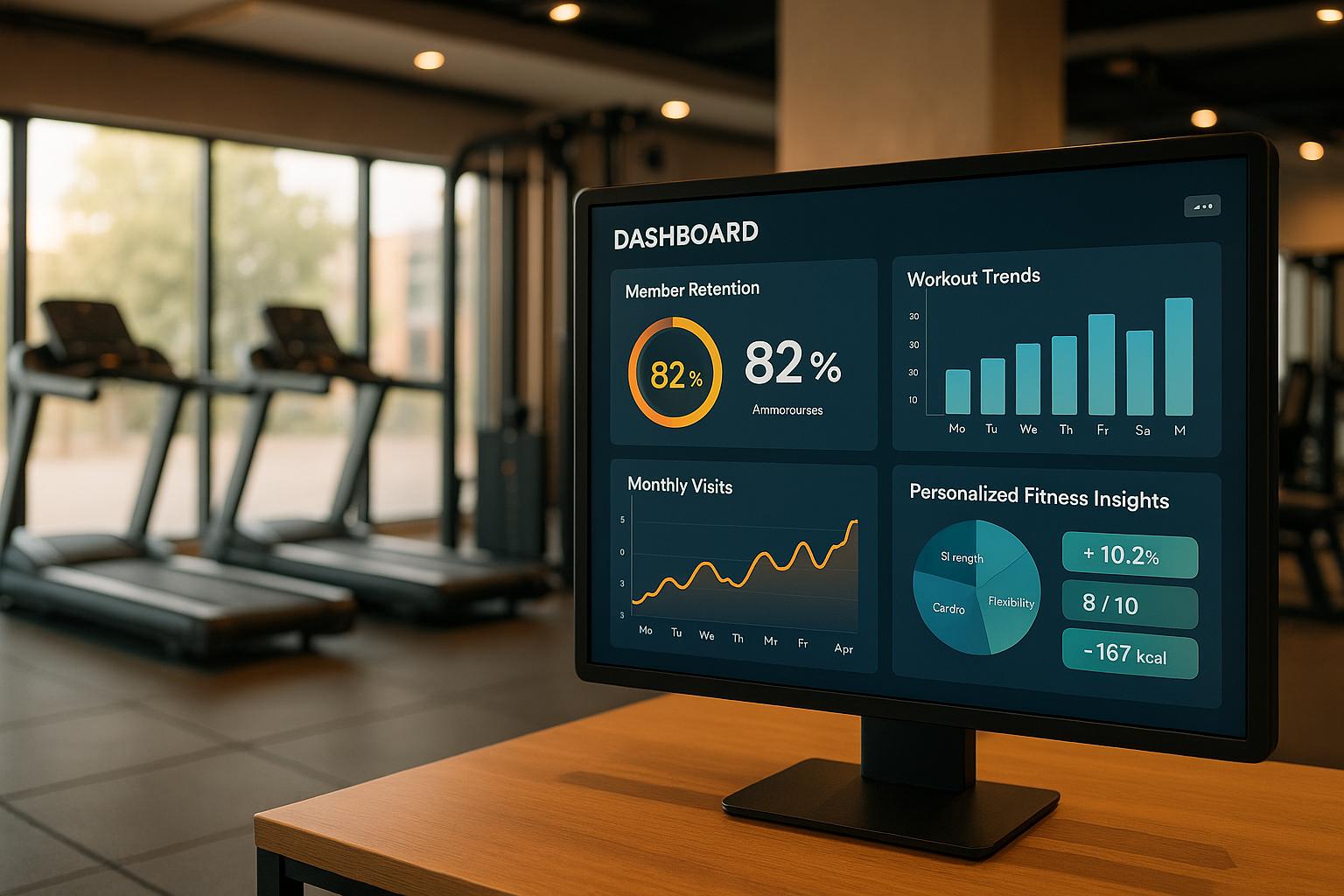Running a gym successfully means tracking the right data every day. Here are five key metrics to focus on:
- Member Check-ins: Track gym usage to adjust staffing, optimize schedules, and identify members at risk of leaving.
- Daily Income Per Member: Monitor revenue from memberships, personal training, retail sales, and more to spot growth opportunities.
- Class Fill Rates: Measure attendance and revenue per class to improve scheduling and instructor performance.
- Equipment Usage: Keep track of machine usage to plan maintenance and avoid downtime.
- Daily Cash Flow: Monitor income and expenses to maintain financial health and make smarter spending decisions.
1. Daily Member Check-ins: Track Gym Usage
What Are Member Check-ins?
Member check-ins are records of when members visit your gym. These records help you understand usage trends, which play a big role in daily operations and keeping members engaged. Studies show that tracking attendance during the first 90–120 days is especially important since higher attendance early on often leads to better long-term retention.
Daily check-in data can help you:
- Spot busy times versus slower periods
- Adjust staff schedules
- Plan equipment upkeep
- Identify members who might stop coming
- Make smarter business decisions
This information is the first step in using technology to improve how your gym runs.
Tools for Check-in Tracking
Modern check-in systems make it easy to track attendance. Members can check in using personal codes, name searches, barcodes, or QR codes. The Fit Ops dashboard takes this data and turns it into easy-to-read reports. These reports, which can be filtered by day, week, or month, help you see attendance trends and member habits in real time.
Ways to Boost Check-ins
- Track New Members Closely: Pay attention to how often new members visit during their first 90–120 days. If their attendance drops, reach out to see if something is preventing them from coming.
- Manage Peak Hours: Use check-in data to figure out when your gym is busiest. Then, adjust staffing and equipment availability to keep members happy.
- Encourage Off-Peak Visits: Look for slower times based on check-in patterns. You can offer special programs or discounts during these hours to spread out facility usage more evenly.
5 Best Gym Management Software Systems in 2024 (Full Demo)
2. Daily Income Per Member
Tracking revenue, much like monitoring member check-ins, helps you identify areas for improvement and make smarter business decisions.
Understanding Member Revenue
Daily income per member is a key indicator of your gym's financial performance. This metric isn't just about membership fees - it also includes earnings from services like personal training, nutrition consultations, challenge fees, and retail sales.
Here’s a breakdown of major revenue sources:
- Membership fees
- Premium service charges
- Personal training sessions
- Nutrition consultations
- Challenge entry fees
- Retail sales (like branded merchandise)
Let’s dive into how you can calculate and analyze this crucial figure.
How to Calculate Member Revenue
To figure out daily income per member, divide your total daily revenue by the number of active members. Tools like the Fit Ops dashboard make this process easier by showing revenue by category and highlighting trends.
| Revenue Source | Contribution to Income |
|---|---|
| Base Membership | Your primary, recurring revenue stream |
| Premium Services | Adds extra income through upgraded offerings |
| Personal Training | Additional revenue from highly engaged members |
| Nutrition Consultations | Promotes wellness while generating extra cash |
| Retail Sales | Boosts income through merchandise purchases |
| Challenge Fees | Typically priced between $50 and $199 |
Ways to Increase Member Revenue
"Increase the average weekly spend per member to boost revenue." – Steve Grant
Here are some actionable ways to grow daily income per member:
- Premium Membership Tiers: Offer upgraded membership plans with perks like unlimited classes or exclusive content to encourage members to step up.
- Recurring Billing: Shift from prepaid packages to automated, recurring payments. This ensures consistent revenue and avoids missed payments.
- Long-term Membership Deals: Provide incentives for 6- or 12-month commitments, such as free guest passes or trial access to premium services.
- Expand Revenue Streams:
- Offer nutrition consultation services.
- Host fitness challenges with entry fees ranging from $50 to $199.
- Sell branded gym apparel or gear.
- Plan seasonal programs (e.g., holiday-themed fitness events).
- Introduce personal training packages to cater to individual needs.
sbb-itb-1efabb1
3. Class Fill Rates
Class fill rates provide insights into how efficiently your gym operates and how engaged your members are. By keeping an eye on attendance trends, you can make smarter choices about your schedule, staffing, and class offerings.
Measuring Class Attendance
Tracking attendance helps identify which classes are performing well. Here are some important metrics to consider:
- Average class size: Total participants divided by the number of classes.
- Fill rate percentage: Actual attendance compared to the class's maximum capacity.
- Revenue per class: Total revenue generated divided by the number of sessions.
"Attributed revenue tells fitness business owners how much actual money was paid per class or workout session. By knowing the attributed revenue by class, time of day, day of week, a gym owner can see where expenses might need to be reduced, or where schedule changes or instructor changes need to be made." - Punchpass
Once you've defined these metrics, use specialized tools to simplify your tracking process.
Tools for Class Tracking
Platforms like the Fit Ops dashboard offer tracking features that can help you manage and analyze class performance. Here's how:
| Tracking Feature | Business Impact |
|---|---|
| Real-time attendance | Keep tabs on class popularity as it happens. |
| Historical trends | Compare attendance across different timeframes. |
| Instructor performance | See which instructors draw the largest crowds. |
| Revenue analysis | Calculate earnings for each time slot. |
These tools give you the data you need to create targeted strategies for improvement.
Steps to Fill More Classes
-
Optimize Your Schedule
Review attendance trends to identify peak times and adjust your schedule accordingly. -
Monitor Instructor Performance
"This fitness business metric tells you how much your community appreciates and values each instructor. It may also be an indicator of the instructor's friendliness, professionalism and skill level. This fitness studio metric is closely tied to attributed revenue and will tell you which instructors are meeting your business's minimum required revenue per class goals." - Punchpass
Use attendance data to spotlight top-performing instructors and address underperforming ones. -
Make Data-Driven Adjustments
Leverage attendance insights to:- Shift class times to better match member preferences.
- Assign popular instructors to high-demand slots.
- Remove or replace classes that aren’t performing well.
- Expand capacity for sessions that consistently fill up.
4. Equipment Usage Tracking
Keeping an eye on equipment usage is just as important as tracking attendance and revenue. It helps you maintain your gym's assets, avoid unexpected breakdowns, and ensure members always have access to the equipment they need. By understanding how your equipment is used, you can plan maintenance and make smarter decisions about future purchases.
Why Track Equipment Use
Monitoring how equipment is used brings several advantages:
| Benefit | Impact on Your Gym |
|---|---|
| Preventive Maintenance | Identify potential issues early |
| Resource Allocation | Determine which machines need backups |
| Cost Control | Lower repair bills with early action |
| Member Satisfaction | Keep high-demand equipment in top shape |
This data, much like attendance and revenue tracking, plays a big role in your gym's daily operations.
Using QR Codes for Tracking
QR codes make equipment tracking easy and efficient. Here's how it works:
- Tagging Equipment: Attach a unique QR code to each machine.
- Logging Usage: Members or staff scan the QR code during each use.
- Collecting Data: Track how often and how long machines are used.
- Analyzing Reports: Use dashboards to review usage trends and get alerts for maintenance needs.
This system helps you identify which machines are most popular and when they need attention.
Tips for Equipment Maintenance
Regular tracking isn’t just about data - it’s about action. Use these tips to keep your equipment in great shape:
- Schedule inspections and maintenance based on usage data, focusing on heavily used machines first.
- Rotate similar machines to spread out wear and tear evenly.
5. Daily Money Flow
Keeping track of daily cash flow helps ensure your gym stays financially healthy and supports informed decision-making. The 2021 "State of the Industry" report by Two-Brain, which analyzed data from 14,162 gyms, emphasizes that monitoring expenses is crucial for running a gym effectively.
What Is Daily Cash Flow?
Daily cash flow refers to the money coming in and going out of your gym every day. Here's a breakdown:
| Income Sources | Daily Expenses |
|---|---|
| Membership dues | Utilities |
| Class fees | Staff wages |
| Personal training sessions | Equipment maintenance |
| Retail sales | Supplies |
| Guest passes | Marketing costs |
By tracking this, you can identify spending patterns, ensuring your gym maintains a positive cash flow. This financial data works hand-in-hand with operational metrics to provide a complete picture of your gym's performance.
How to Track Money Effectively
Gym management software can simplify the process of monitoring your finances. Focus on these key metrics:
| Metric | What to Track | Why It Matters |
|---|---|---|
| Income | All revenue streams | Pinpoint peak earning periods |
| Expenses | Fixed and variable costs | Manage spending efficiently |
| Net Daily Cash | Revenue minus expenses | Measure daily profitability |
Always evaluate the return on investment (ROI) for each expense to ensure your spending supports growth.
Practical Money Management Tips
- Log every transaction: Keep a detailed record of all income and expenses.
- Review daily reports: Spot errors early and balance growth with cost control.
- Leverage reporting tools: Use software features to detect trends and make informed decisions.
"If you don't track your expenses, you'll have no idea how they affect your cash flow, and your profit could disappear in a heartbeat." – Two-Brain's State of the Industry Report
Consistent cash flow tracking is just as important as monitoring other performance metrics. It lays the foundation for smart, data-driven decisions and long-term success.
Conclusion: Use These Metrics Effectively
Tracking the right metrics is crucial for running a successful gym. Consistently monitoring these numbers helps you make smarter decisions, with studies showing it can lead to 2.6× higher ROI. Gym management software can simplify the process, helping you stay on top of these five key metrics and improve both growth and member satisfaction.
Here’s a quick overview of how these metrics impact your gym:
| Metric | Business Impact | Key Benefits |
|---|---|---|
| Member Check-ins | Tracks usage patterns | Adjust staffing and class schedules |
| Daily Income/Member | Monitors revenue health | Spot growth opportunities |
| Class Fill Rates | Measures program success | Optimize resource use |
| Equipment Usage | Avoids maintenance issues | Prolong equipment lifespan |
| Daily Cash Flow | Maintains financial health | Smarter spending decisions |
Make it a habit to review your metrics dashboard every morning. This routine helps you catch trends early and solve problems before they grow. In fact, businesses that regularly analyze their data are 23 times more likely to attract new members.
Let the data guide your actions. For example, adjust class schedules if attendance drops or revisit pricing if member revenue declines. By relying on data instead of guesswork, you can consistently improve your gym’s operations and keep members happy.


